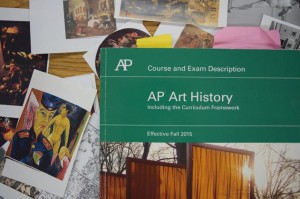by Yasir Khaleq, Staff Writer
The Advanced Placement (AP) Art History course and exam received a major remodeling at the beginning of the school year from the College Board, affecting many students at FVHS.
“Previously, we were basically told: go for it. The teachers had to do a lot of guessing,” said Brenda Silvertooth, an AP Art History teacher. “There’s no longer guessing the entire book and hoping you pick the right pieces. They tell you the exact pieces you need to cover for the exam, which is great.”
The curriculum has now become much more focused on analyzing and understanding a smaller amount of art pieces, rather than simply knowing a few details about a larger quantity of art pieces. Before the change, teachers covered upwards of 1200 pieces of art. Now, the College Board instructs teachers on the exact 250 pieces of art work they must cover.

The test itself has also undergone major changes, mainly in terms of structure. The significant narrowing of art pieces students must cover makes it easier to study and understand the possible content for the exam.
“The exam in the past would have 115 multiple choice questions, two 30 minute essays and six 10 minute essays. The exam will now have 80 questions multiple choice, two 30 minute questions and four 15 minute questions,” said Silvertooth. “The exam would be about 20 percent art beyond the European tradition and prehisotric art would not appear on the essay portion, and the exam would cover art through 1990.”
This change has been in the making for five years now, when the curriculum design committee began designing the new course. The Implementation Committee (which Silvertooth was a member of) has been preparing for the transition for three years. These changes were made for a variety of reasons, with the ultimate goal being to make the AP Art History course more significant.
“[The change] was done to align more closely with what college classes are offering to their students. They wanted to add more depth to the coverage itself as opposed to breadth,” said Silvertooth.
Silvertooth believes the test will have a noticeable effect on students and teachers alike, almost certainly for the better.
“Many parts of the test will be easier. Knowing exactly which 250 pieces you need to know makes for an easier mountain of evidence. However, they need to know the material in more depth,” said Silvertooth. “The need to examine pieces in detail is still there. There’s a little bit more of a memorization factor, since the college factor has asked that dates of production be included and not just period of production.”
Students will also be working out more skills than prior AP Art History students have in the past.
“Students are doing a little bit more analysis than they’ve done in the past,s o it’s a more manageable course, but it’s not necessarily an easier course,” said Silvertooth.





